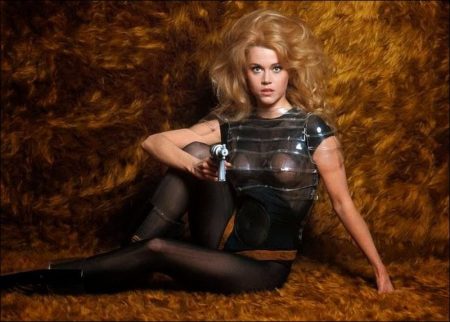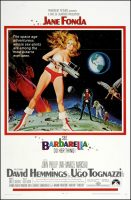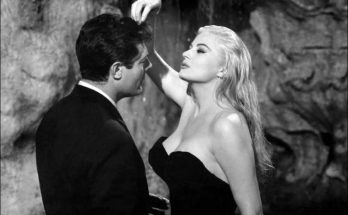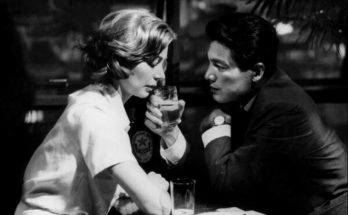Today, there are countless superheroes on the movie screens. Batman and Superman on the hand, and Marvel’s superheroes on the other hand, fight against the bad guys who want to take over our world. Looking back on the past years of cinema, we see that the audience was also interested in superheroes in those years. They were very few, but they tried to save the world.
When we look at 1968 we see Barbarella. Barbarella, played by Jane Fonda, is a woman superhero who lives in the 41st century, far far away from the present day. She is tasked by the United World Government, to which he belongs, to find the scientist Durand Durand, who can end humanity with positive rays.
Producer Dino De Laurentiis bought the rights to make Barbarella a film. Vadim took on the role of director as if he were a comic book fan and wanted to adapt the film. Before he divorced his wife Jane Fonda, Vadim tried to propose to several actresses, including Virna Lisi, Brigitte Bardot and Sophia Loren. Vadim asked his friend Terry Southern to write the script; This scenario was changed drastically during filming, and some other authors were involved.

The film became particularly popular when it was released in the UK as the second-highest-grossing film of the year following The Jungle Book. Today’s film critics praise the visuals and cinematography of the film, but after the first few scenes they find the film’s story weak. Since the release of the sequels, several attempts have been planned to restructure and other adaptations, but none of them have been produced.
Barbarella (Jane Fonda) exclaims as the evil scientist Durand-Durand (Milo O’Shea) begins to play upon his nefarious piano-like Excessive Machine. The scene, like the B-sci-fi goof Barbarella as a whole, is famous for its winking sexuality; you see Fonda’s clothing being spit out of the machine, and then she moans and sweats and writhes in the sensuous clutches of Durand’s pleasure trap.
But for all of the film’s double and single entendres, the truth is (as Barbarella well knows) that sex is easy to find everywhere. What really makes Barbarella special isn’t sex. Rather, as the main character says in surprise, what makes Barbarella special is that it’s “nice”.
Many actresses were contacted before Jane Fonda portrayed Barbarella. De Laurentiis’s first choice was Virna Lisi. The second was Brigitte Bardot, who did not want to play sexual roles. The third option was Sophia Loren, who rejected the offer as she was pregnant, and thought she would not play the role.
Jane Fonda was unsure of the film, but was convinced by director Vadim for declaring that science fiction belongs to a rapidly evolving genre. Before filming Barbarella, Fonda was the subject of two major scandals; The first scandal occurred in 1965, when his naked body appeared on an eight-story billboard promoting the Circle of Love premiere, and the second in 1966 when Vadim sold several intimate nude shots in a closed set called The Game Is Over to Playboy. Biographer Thomas Kiernan, in particular, argued that the Billboard incident described Fonda as a sex symbol in the United States.
Barbarella was released in New York on October 11, 1968. The film earned $2.5 million in North America in 1968. Following The Jungle Book, the film became the second most popular film in the UK in 1968. It was also screened in Paris in October, and in 1968 it was shown in Italy. Released by Paramount and released on October 25, 1968 throughout France.
Barbarella is Mr Rogers as Jesus Christ as Marilyn Monroe; the sex bomb who will bring about world peace while reassuring you that you’ll never go down the drain. The fun of the film is giggling at this premise. Viewers of the film in 1968 knew that the hippies nattering on about peace and love and pleasure weren’t going to save them. Vietnam ground on no matter how fetchingly Barbarella tossed her hair and lost all her clothes. The secret invisible key to the tyrant’s Chamber of Dreams is a literally transparent fiction. It’s made up; it isn’t there. The sexy utopia is a myth. Barbarella encourages you to feel smart for laughing at the very idea.
But laughing at the fantasy is one way, half-surreptitiously, to enjoy the fantasy. No sex goddess is going to swoop in wearing vinyl and make all the nuclear weapons – er, positronic rays – disappear. The lion won’t lie down with the lamb, the angel won’t virtuously rescue the bisexual tyrant queen, and the nations of the world aren’t going to choose sex over war. We snort at the very idea. But, oh, if they did! It would be sort of nice, wouldn’t it?
The real naked truth of Barbarella isn’t sexploitation. It’s niceploitation; the cynical exploitation of utopian goodness and, conversely, the starry-eyed utopian exploitation of cynicism. Like Barbarella’s outfits, the film is carefully and delicately constructed, mocking its own dreams of pleasure and peace the better to indulge in them to sensual excess.
Barbarella (1968)
Directed by: Roger Vadim
Starring: Jane Fonda, John Phillip Law, Anita Pallenberg, Milo O’Shea, Marcel Marceau, Claude Dauphin, Véronique Vendell, Giancarlo Cobelli, Serge Marquand, Marie Therese Chevallier
Screenplay by: Jean-Claude Forest, Terry Southern
Production Design by: Mario Garbuglia
Cinematography by: Claude Renoir
Film Editing by: Victoria Mercanton
Costume Design by: Jacques Fonteray, Paco Rabanne
Music by: Bob Crewe, Charles Fox
MPAA Rating: None.
Distributed by: Paramount Pictures
Release Date: October 10, 1968
Views: 853





